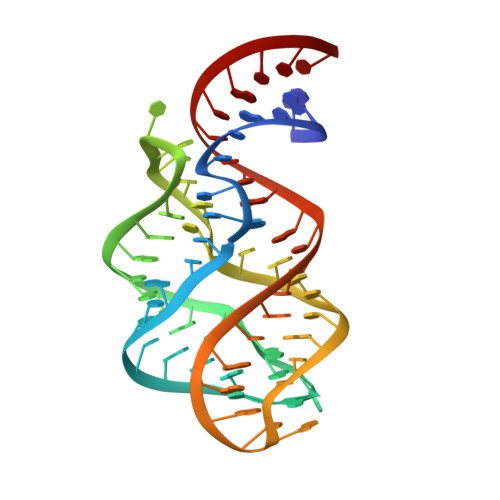Mutational analysis of the purine riboswitch aptamer domain
Gilbert, S.D., Love, C.E., Edwards, A.L., Batey, R.T.(2007) Biochemistry 46: 13297-13309
- PubMed: 17960911
- DOI: https://doi.org/10.1021/bi700410g
- Primary Citation of Related Structures:
2EES, 2EET, 2EEU, 2EEV, 2EEW - PubMed Abstract:
The purine riboswitch is one of a number of mRNA elements commonly found in the 5'-untranslated region capable of controlling expression in a cis-fashion via its ability to directly bind small-molecule metabolites. Extensive biochemical and structural analysis of the nucleobase-binding domain of the riboswitch, referred to as the aptamer domain, has revealed that the mRNA recognizes its cognate ligand using an intricately folded three-way junction motif that completely encapsulates the ligand. High-affinity binding of the purine nucleobase is facilitated by a distal loop-loop interaction that is conserved between both the adenine and guanine riboswitches. To understand the contribution of conserved nucleotides in both the three-way junction and the loop-loop interaction of this RNA, we performed a detailed mutagenic survey of these elements in the context of an adenine-responsive variant of the xpt-pbuX guanine riboswitch from Bacillus subtilis. The varying ability of these mutants to bind ligand as measured by isothermal titration calorimetry uncovered the conserved nucleotides whose identity is required for purine binding. Crystallographic analysis of the bound form of five mutants and chemical probing of their free state demonstrate that the identity of several universally conserved nucleotides is not essential for formation of the RNA-ligand complex but rather for maintaining a binding-competent form of the free RNA. These data show that conservation patterns in riboswitches arise from a combination of formation of the ligand-bound complex, promoting an open form of the free RNA, and participating in the secondary structural switch with the expression platform.
- Department of Chemistry and Biochemistry, University of Colorado at Boulder, Campus Box 215, Boulder, Colorado 80309-0215, USA.
Organizational Affiliation:



















